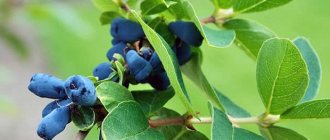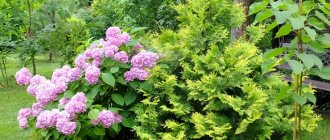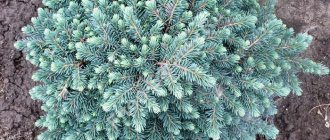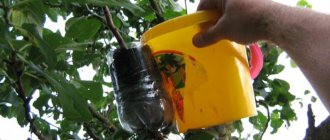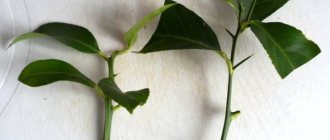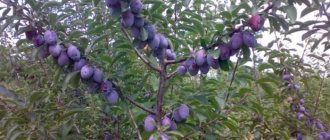Reproduction
The mulberry tree has good reproduction ability.
You can get new specimens using cuttings, seeds, maternal offspring, or by grafting. Of course, in order to grow an adult tree using any of the indicated methods, it will take not only time, but also some effort. Let us immediately note that the success of any endeavor depends on a positive attitude, faith in success and diligence. And so, in order to get mulberries and seeds, you must first collect the seeds; for this, well-ripened berries are selected, kneaded and washed with a sieve and water. Then the seeds can be immediately planted in specially prepared containers with nutrient soil. Shoots appear after two weeks. Young seedlings grow up to ten centimeters by autumn. To ensure they overwinter well, the trees are dug up, placed in damp sawdust and stored in the basement. If the seedlings were grown in open ground, then you do not need to dig them up, but cover them with dry leaves and grass to protect them from frost.
Note that mulberry seeds can be stored, so collected in the summer, they are dried and stored in fabric bags. Before planting, at the beginning of spring, they are soaked in water for a day, after which they are planted in open ground.
Since mulberry seeds are quite small, the maximum planting depth should not exceed two centimeters.
Seed propagation is used to breed new varieties and to grow rootstocks for varietal seedlings. For other purposes, other methods of propagation are used, since the seed tree does not retain the characteristics of the mother tree.
In order to grow a tree with identical characteristics of the mother tree, a vegetative propagation method is used. You can use layering. To do this, you need to bend the lower branch of the mulberry to the ground, fix it and cover it with soil. In order for the branch to take root as quickly as possible, it is recommended to break it at the point of fixation and remove a little bark. This manipulation is done in early spring; as a rule, small roots appear by autumn. You need to let the cuttings get stronger until spring. You just need to cover it for the winter.
The vegetative method also includes mulberry grafting. The most effective spring budding is a germinating eye. Other methods do not always give positive results. Although theoretically they should all be successful.
For eye grafting, it is necessary to prepare buds from last year's shoots. To do this, you can prepare cuttings in the fall or cut them in early spring. Budding is carried out using the butt method.
A fairly popular method of propagating mulberries is cuttings, which can be carried out using lignified, semi-lignified and green cuttings.
The most optimal method for mulberries is propagation by semi-lignified cuttings. Firstly, it has a high rooting rate, and secondly, it is suitable for all types of trees.
A few words about how cuttings are prepared and planted. This propagation process begins at the end of June, when young green shoots begin to become woody. They are cut so that at least two buds remain. The upper cut ends slightly above the upper bud, and the lower one is made directly under the eye. Then the shoots are cleared of leaves, treated with a stimulant and planted in pre-prepared greenhouses or under a plastic bottle at a slight slope.
Rooting cuttings does not take much time; as a rule, by autumn the first buds may appear on the shoots - this is a clear sign that the cuttings have taken root.
You can also use two other cutting methods. The resulting seedlings, after rooting, can be dug up and moved to the basement for the winter or left in open ground, while covering them.
Mulberry (lat. Morus),
or
mulberry tree,
or
mulberry
- a deciduous tree that belongs to the genus of the Mulberry family and, according to data from various sources, has from 17 to 24 species. Representatives of this genus are widespread in the subtropical and temperate zones of North America, Africa and Asia. The leaves of white mulberry, one of the most popular species of the genus, are a source of food for silkworm larvae, whose pupae are used to produce natural silk. In Russia, mulberry was already known under Ivan the Terrible - a specially created silk-weaving manufactory cultivated the most delicate fabric for the royal court, and Peter I, due to the high value of the tree, banned its felling on the territory of the state. The elastic, dense and heavy wood of the mulberry tree is considered very valuable - in Central Asia, musical instruments, crafts, and barrels are made from it.
Growing mulberries in the garden
You need to care for mulberries grown in the garden in the same way as other crops. It needs to be watered, weeded, pruned, fed, treated against pests and diseases in a timely manner, and the surface of the tree trunk needs to be loosened.
Mulberry processing
To significantly reduce the risk of a tree being damaged by various diseases or pests, it is necessary to regularly carry out preventive treatments, and it is necessary to spray not only the plant itself, but also the surface of the tree trunk circle. Insecticides and fungicides are used for treatments. It is recommended to carry out such spraying in the first days of April on dormant buds, as well as in October, when the growing season ends. A solution of Nitrafen or Bordeaux mixture (3%) will help you cope with various diseases and pests. In the spring, it is recommended to spray the tree with a urea solution (7%), which will destroy all pests and pathogenic microorganisms, and will also become a source of nitrogen for the plant, which it so needs at the beginning of the growing season.
Watering mulberries
To make the mulberry tree more winter-hardy, it must be watered regularly from the beginning of spring until July. This should be done during severe drought. Starting in July, the plant cannot be watered. If there is a large amount of rain in spring, then there is no need to water the mulberries.
Mulberry feeding
From the beginning of spring until July, such a tree needs feeding. In spring, the plant most of all needs nitrogen fertilizers, and in summer - potassium and phosphorus fertilizers.
Mulberry in the Moscow region and Moscow
The Moscow and Moscow region climate is not entirely suitable for growing mulberries. However, they have long since learned to grow such southern crops as apricots, grapes, and mulberries are no longer so rare. This plant, covered with snow, can survive air temperatures dropping to minus 30 degrees. However, if the winter period turns out to have little snow, then the mulberry tree may die even when the temperature drops to minus 7–10 degrees. In this regard, when planting mulberries in the Moscow region, its root collar should not be deeply buried in the soil.
Since the length of daylight hours in the Moscow region does not meet the requirements of mulberries, such a plant, which is grown in the Moscow region, has 2 growing seasons per year - in spring and autumn. This tree has an unusual ability; it can form cork tissue between the mature and unripe parts of the stem. As a result, in the autumn the mulberry tree can shed those parts of the shoot that are not viable, which will allow it to survive the winter well. In this regard, in the autumn in the Moscow region and Moscow, not only the leaf blades of such a crop fly off, but also parts of the stems. This is the only difference in mulberry cultivation compared to warmer regions.
Mulberry in Siberia
This plant can be cultivated in Siberia only if its frost resistance is increased. This is difficult to do, but possible if desired. If a gardener has a very strong desire to grow mulberries in a region with a cold climate, then he should definitely study the articles of experienced gardeners V. Shalamov and G. Kazanin.
Popular types and varieties
White mulberry
White mulberry
The homeland of this species is the mountain forests of China. Deciduous trees grow from 8 to 20 meters. The crown of a young plant is dense and narrow. With age, it grows and takes on a rounded shape.
- The bark is grayish-brown, with a brown tint in some varieties. It is prone to cracking.
- The shoots are gray, straight and flexible. Young ones are covered with silky hairs, becoming bare with age. The buds on them are reddish and small in size.
- Foliage of different sizes. Length from 7 to 20 centimeters. They are wide oval or ovoid in shape. On young shoots and fruiting branches the leaf blades have a smooth edge, but on the rest they have serrations. Leaves grow on petioles. Their length is about 2 centimeters. Their surface is densely covered with fluff.
- The fruit is 1.2 - 2.5 centimeters long. Color varies from white to purple. Depending on the variety. Each individual segment of the fruit is 1-2 millimeters in diameter. Their taste is sweet, the flesh is juicy with a subtle, barely perceptible aroma.
In the southern regions, flowering occurs in April-May, in colder climates in May-June. Withstands frosts down to -29 degrees.
This variety of mulberry has become widespread.
The species contains a large number of decorative varieties:
1Aurea - young shoots and leaves are golden in color when blooming. They turn green with age. The maximum height of the tree is 15 meters.
2 Constantinople - the height of a deciduous tree does not exceed 8 meters. Its shoots are thickened. The leaves are large. The average length of the leaf plate is 15 centimeters.
3Fruitless is a deciduous tree with a spreading, rounded crown. Its height is 10-15 meters. The surface of the leaf plate is rough and shiny.
4Multicaulis - is a shrub up to 5 meters high. It is characterized by rapid growth, thanks to multiple root shoots. The fruits are dark, almost black when fully ripe.
5Pendula is a deciduous tree from 7 to 10 meters tall. It has weeping branches. They are thin and long, hanging down to the ground. The leaves are large in size.
6Tatarika is one of the most unpretentious varieties. It is characterized by high frost resistance. It is represented by bushes up to 3 meters high. The fruits are small, but very sweet.
Black mulberry
Black mulberry
Black mulberry
The origin of the species is twofold: some scientists believe that it is from South-West Asia, others that it is a cultivated variety that has gone wild over time.
It is a deciduous tree from 6 to 15 meters tall. The crown diameter of an adult plant is about 15 meters.
- The crown is round and widely spreading. Formed from branches on a short curved trunk. Its bark is highly fissured, with a rough surface.
- The leaves are of different sizes, so on the fruiting branches they are smaller. Their length is about 12 centimeters. The rest reach 20 centimeters in length. Their base is heart-shaped.
- The leaf blade is asymmetrical. The lower part is covered with fluff.
- The berries are 2-2.5 centimeters long. Their flesh is juicy with a sweet and sour taste. At first they are green in color and become dark when fully ripe.
The flowering period occurs in April-May. It begins to bear fruit in July.
It can withstand winter frosts no lower than -25 degrees.
The species is common among gardeners. Cultivated more for its fruits or for silkworm farming. Rarely used as an ornamental plant.
Red mulberry
Red mulberry
Red mulberry
The species is widespread in Canada and the Eastern United States. Deciduous tree about 15 meters high. Some specimens grow up to 20 meters.
- The bark is red-orange, prone to cracking. The shoots are covered with gray skin and pubescent.
- The leaves are different, the length varies from 7 to 20 centimeters. Their shape can be round and ovoid. The base is truncated or rounded. The apex is often pointed. They grow on petioles, 2.5 centimeters long. They can be red and green.
- The berry is 2.5-4 centimeters long. The shape of the fruit is cylindrical. When ripe they turn red. The pulp is sweet, with sourness.
Blooms flowers in May. In July you can enjoy juicy berries.
This species has increased frost resistance down to -34 degrees.
Red mulberries have been grown in gardens since 1629. It is widespread on the North American continent.
How to make and decorate beautiful garden beds with your own hands: simple, tall, smart. For flowers and vegetables. Original ideas (80+ Photos & Videos)
Advantages and disadvantages of weeping mulberry
First of all, those gardeners who have at their disposal a very small plot of land should think about growing weeping mulberries. These plants do not grow tall, so they will occupy a very small area of the garden. At the same time, the yield of willow mulberries is no worse than that of ordinary ones. The fruits are just as tasty, sweet, healthy, and most importantly, there are a lot of them on the plants. However, there is also a disadvantage to this species - the berries do not last long and begin to deteriorate within 12 hours after picking.
To ensure that standard weeping mulberry trees have a decorative appearance and are not too tall, it is recommended to trim and shape them. Excess branches are cut off, and the trees can be shaped into a ball or broom. In the fall, trees must be insulated, since it is the young shoots that have the risk of freezing with the onset of low negative temperatures.
We can conclude that growing weeping mulberry is very profitable. It will not only be able to decorate the area as an ornamental plant, but will also reward you with a rich harvest of tasty and healthy berries.
Botanical description
Mulberry is a low (about 15 meters) deciduous tree that belongs to the genus of plants in the Mulberry family (Moraceae). It is also called mulberry tree. Mulberry leaves are simple, heart-shaped, serrated along the edges.
Mulberry trees are male and female, so the flowers that open on them are different. On some monoecious trees, small flowers of both sexes bloom, collected in inflorescences. Mulberries bloom from mid-spring to early summer.
Mulberry berries appear only in the fifth year of growth in open ground. They look like blackberries, but have an elongated shape. Mulberry fruits ripen by mid-summer. Their color depends on the variety. Ripe berries are easily separated from the stalk.
Mulberry has a wide spreading crown. There are weeping species, their long thin branches tend downwards. The bark is brown, all cracked. Here it can live in good climatic conditions for up to 500 years.
Types and varieties
The mulberry genus includes many varieties and species, some of which are hybrids. The main types used by gardeners are:
- Mulberry is white. Tall mulberry tree with a voluminous crown. Leaves come in different sizes and shapes. Bright green in summer, turning yellow in autumn. Ripe, sweet fruits are white in color with various shades. Some varieties have white, black, and red berries at the same time. The plant tolerates winter well and can grow on city streets. Known varieties:
- White honey. Tall variety with large berries. It got its name for the snow-white color of mulberry fruits and their very sweet taste;
- Luganochka. The advantages of the variety are productivity and fruit size. The berries are large, up to 55 mm in length;
- Ukrainian-6. It begins to bear fruit early and brings a large harvest. Mulberries are black, up to 4 cm in length;
- Crying. Used in landscape design. It is grown more for decoration of the site than for high yield. Thin branches gracefully fall down. Can grow up to 5 meters;
- Golden. Young stems and leaves are colored yellow-golden and make this variety decorative.
- Black mulberry. Mulberry tree with a wide crown and spreading branches. Grows up to 15 meters. The branches have thin stems with large leaves, up to 20 cm in length. The front side of the sheet is smooth. The back side of the leaves seem to be covered with fluff, soft to the touch. The average length of black juicy mulberries is approximately 3 cm. The taste of the fruit is sweet and sour. It grows well in drought, but does not tolerate frost as well as other species. The most famous varieties:
- Royal. The largest-fruited mulberry. The berries can grow up to 6 cm. The crown of the tree is dense and spreading. The leaves are shiny, dark green. Mulberry grows up to 8 meters in length, tolerates frosty winters and dry summers;
- Hope. The crown shape is cup-shaped, dense, with large leaves. It differs from other varieties in that the fruits stay on the tree for a long time when ripe and do not fall off prematurely. Mulberry fruits are cylindrical in shape with large drupes, have a sweet and sour taste, and are not very juicy;
- Black Prince. It differs in that it easily tolerates drought and bears fruit already in the second year after planting. The plant is quite tall, can grow up to 10 meters. Mulberry leaves are large and oval in shape. The branches grow densely, forming a dense crown, so it is recommended to thin them out. The fruits are very sweet, juicy and grow up to 5 cm;
- Shelley. Early ripening variety of mulberry tree. It begins to bear fruit with large, dark purple, sweet berries at the end of May. The tree withstands winter, but it needs abundant watering in hot, dry summers;
- Remontant. Dwarf variety of mulberry. It can be grown in a large flowerpot or pot.
- Red mulberry. This type of mulberry tree is the most unpretentious of all. Easily tolerates cold, drought, and poor conditions. This plant with a spherical crown can grow up to 20 meters. The leaves are slightly rough to the touch, oval in shape with a pointed tip. Fruits with dark red, burgundy sweet, juicy berries. Popular varieties:
- Vladimirskaya. Can be grown as a shrub. But if you remove the top of the central trunk, you can change the shape to a weeping one;
- Felt. Decorative variety of mulberry tree. So called because of the felt-like pubescence of the leaves on the back side.
Mulberry: what it looks like, features
Young mulberries grow quite quickly, but growth slows down over the years. As a rule, the height of an adult tree is 13-15 meters. The foliage is quite dense, the leaves are alternately arranged, with a serrated edge. Inflorescences are male and female. Most often, monoecious plants are found, i.e. those on which both female and male inflorescences open. But there are also dioecious ones. On trees with male inflorescences, as a rule, the foliage is larger and lobed.
Mulberry fruiting begins at 5-6 years of age and lasts on average up to 200 years. But the oldest mulberry or mulberry grows in Uzbekistan; the tree is more than 600 years old.
Vaccination in summer
There is a method of propagating mulberries using the “sleeping eye”. It is practiced in early August after the harvest. In the middle zone, work is best done at the end of July. From a one-year-old branch, it is necessary to prepare a cutting with one eye and graft it using the simple budding method.
If the technology is followed, the scion will take root in 2 weeks. The results may be affected by dry days, insufficient watering or heavy rains. But the attachment point should not be opened until next spring.
How to prepare mulberry grafting for winter
In strong winds or heavy rain, the joints of the sections are often displaced. If the mulberry grafting is not prepared for winter, it may die. Therefore, it is better not to remove the insulating material for 2–3 months.
After grafting, you can lubricate the sections with garden varnish to prevent the entry of fungus or bacteria. If the polyethylene is torn, it is better to replace it intact by winter. Mulberries can be fed with organic fertilizers and watered more often in the dry season. By spring, it is recommended to slightly loosen the fixing material to improve the delivery of juice to the cutting.
Care
A set of mulberry care measures includes:
Watering mulberries is carried out in dry years from spring to mid-summer. In rainy times it does not require watering.
By the way, a tree’s frost resistance increases if it lacks moisture in the autumn.
After the moisture is absorbed into the soil, it is necessary to loosen the top layer . This will prevent the ground from crusting and cracking.
A layer of mulch will eliminate the need for loosening. It will also prevent the growth of weeds under the tree.
Feeding is carried out in a similar mode. Fertilizers applied in the spring should contain nitrogen, and in the summer mixtures with phosphate and potassium are preferable.
Pruning is a necessary measure when caring for a mulberry tree. It should be carried out when the plant is dormant, that is, in early spring or late autumn.
In the spring, before the buds appear and the leaves bloom, 2 types of pruning are carried out:
The third type is sanitary pruning, carried out in the autumn. The right time for it is when the leaves have fallen and the air temperature drops below 0. But it should not be below -10 degrees.
Each variety is pruned in different ways:
During sanitary pruning, you need to remove dry and broken branches . It can be carried out not every year, but as needed.
Another care measure is preventative treatment , aimed at minimizing damage to the tree by pests and diseases. The tree itself and the tree trunk are treated with fungicides and insecticides.
Suitable for processing beginning of April and end of October. That is, in the spring, before the buds have yet bloomed, in the fall, when the plant has gone into a dormant state.
Description of black currant variety Nara, planting and care
In spring you can use urea . The solution needs 7%. This product will not only kill pests, but will also serve as a feed for mulberries awakening from winter.
How to propagate mulberries from cuttings
Propagation of mulberries by green and semi-lignified cuttings, as a rule, does not cause any difficulties. Cuttings with lignified planting material are a little more difficult and take longer. In addition, the yield with this dilution is less. If from semi-lignified cuttings, which are planted in June, full-fledged seedlings grow by autumn, then it will take at least a year to grow lignified cuttings.
How to propagate mulberries from cuttings in the fall
In autumn, mulberries are propagated through lignified cuttings. The process of preparing planting material looks like this:
- In the fall, before the onset of frost on the mulberry tree, a strong woody shoot is selected from the upper part of the plant.
- Cuttings of 15-18 cm are cut from it.
- The resulting cuts are treated in the lower part with any root formation stimulator (for example, “Kornevin”). This treatment of the lower cuts will ensure better rooting of the planting material in the future.
- Then the cuttings are planted on a previously prepared bed, deeply buried. There should be no more than 5 cm above the ground surface.
- Germination of cuttings in this place lasts for 2 years. After this, seedlings with a complete root system can be replanted.
How to propagate mulberry by cuttings in spring
In spring, mulberry propagation by cuttings is combined with grafting onto the rootstock. Preparation of planting material begins in the spring, in mid-March
It’s important to get there before the buds start to bloom.
The breeding procedure looks like this:
- Cuttings of equal length are cut from the mulberry tree.
- The day before grafting, the sections on the lower side of the cut cuttings are renewed.
- Then they are placed with their renewed ends in clean water at room temperature.
- Two cuttings are selected - scion and rootstock. They make an oblique cut and combine the cuttings together. The cuts are firmly fixed with a bandage or plastic wrap. This method is called simple copulation.
Mulberry propagation by cuttings in summer
In summer, it is best to propagate mulberries using green cuttings. The procedure for harvesting green cuttings is as follows:
- In June, a healthy shoot is selected from the mulberry tree, quite soft to the touch (herbaceous). It must be from the current year.
- Cuttings are cut from the selected branch so that each cut contains 2-3 buds.
- Each cutting is cleaned - the leaves at the bottom are removed.
- The remaining leaves are cut in half. This is necessary for the further development of the cutting.
- The resulting planting material is planted in a greenhouse to a depth of 3-4 cm.
- During growth, the cuttings are watered moderately, trying not to overwater - stagnant moisture is detrimental to mulberries.
- The greenhouse is ventilated from time to time, and as the planting material grows, this period is increased from several minutes to half an hour.
- A month after planting, the cuttings are fertilized with mineral fertilizers.
- After about 30-35 days, the planting material should form a full-fledged root system.
Propagation of mulberries using semi-lignified cuttings is an excellent alternative to green cuttings. In July, the mulberry already forms strong, healthy branches, but they do not have time to become lignified by this time. Such shoots are cut off in June. Caring for seedlings is similar to growing green cuttings. The only difference is the longer dilution period: the procedure takes 1.5 months.
Which tree can mulberries be grafted onto?
Mulberry (mulberry) is a completely unique tree that is grown by many summer residents on their plots. It bears fruit almost every year. The berries are sweet, sometimes sour, and have medicinal properties.
The tree is unpretentious to care, soil, moisture, and climatic conditions. It’s enough just to plant it – and it grows and bears fruit. Moreover, it reproduces very easily from seeds and does not lose its maternal qualities.
The question arises: what is the purpose of grafting such a tree?
Why is mulberry grafting done?
The mulberry tree grows up to 20 meters. If the mulberry is white, but you want to plant another black one, it is not possible to plant another such powerful plant in a small area.
And to no avail. It is enough to vaccinate different varieties on one tree. And you will have all the varieties of culture you want.
Amateur gardeners, using grafting, achieve on one tree a harvest of mulberries of different varieties and different colors - white, pink, red, black.
They ripen at different times and delight their owners with sweet berries for a long time. Vaccinations are given in other cases:
- To increase crop yields and improve the quality of berries.
- When you want to start a different variety. Some varietal plants improve their characteristics if they are grafted onto wild frost- and drought-resistant mulberries.
- Mulberry is a dioecious crop. There are males that bloom well but do not produce crops, and females that bear fruit well. The female shoot is grafted onto the male stamp - and the tree begins to bear fruit (at 4-5 years).
- Many gardeners are not happy with fruiting in the 5th year. They graft mulberry onto an adult tree, and it begins to bear fruit earlier (after 2-3 years).
- To reduce the height of a tall crop, a weeping or spherical variety is grafted onto low-growing fruit trunks 1.5-2 meters high (even dwarf specimens are grown).
Experimenters graft a vine onto a mulberry tree, which quietly develops along with the tree.
When to graft trees
Vaccinations are carried out in spring, summer, and winter. The middle of the spring period - the beginning of the growing season - is most suitable for performing grafting work. The buds of the rootstock tree swelled, but no flowers appeared.
Juices circulate. This time accounts for the highest percentage of successful vaccinations. Summer vaccination from July 25 to August 25 is carried out if the spring vaccination was unsuccessful.
Gardeners who carried out work in the summer performed the process at the end of fruiting. At this time, the grafted shoot has time to take root, produce buds, and even bear fruit the following year.
It is advisable to do it before July, when the heat begins and the cutting with the eye may dry out. During summer work, the budding method is used.
Along with the eyes taken from the middle of the cutting, a bud is grafted from the top of the growth shoot. Winter grafting is performed indoors. Seedlings intended for planting in the spring are grafted.
To carry out the work, choose a warm, cloudy, windless, not rainy day. The best time is early in the morning or evening.
Required Tools
When carrying out the procedure, gardeners use special tools. They are sharp and adapted for vaccinations.
An ordinary knife, which gardeners sometimes use, is not sharp enough to make cuts without injuring the plant.
List of necessary tools and materials
- garden knife,
- copulation knife with a wide blade,
- budding with a curved blade,
- gardening scissors,
- pruner,
- soft polyethylene film (for tying),
- electrical tape to secure the dressing,
- garden varnish or oil paint for processing cuts.
Preparing for the vaccination procedure
Before starting the procedure, mulberry cuttings are checked. They select dry, rotten, frostbitten ones. To check, lower the cuttings, on which small cuts are made, into a container with clean water.
The water will remain clear if everything is in order. Frozen workpieces will turn the water yellowish. Tools are sharpened, cleaned, and disinfected with alcohol, on fire, with a 1% solution of potassium permanganate.
Disinfection of instruments is carried out in order to prevent infection from being introduced into the incisions.
Mulberry copulation
Copulation is called grafting with a cutting onto a cut. To carry it out, cuttings are prepared in advance - in early March, late February, from November until the first frost.
Dormant buds of such cuttings wake up in the spring. The bud blooms after 2 weeks, which indicates the success of the procedure.
After some time, the polyethylene is unwound.
Preparation of mulberry cuttings
For harvesting, annual shoots (10-15 pieces) are cut from the south side of a healthy tree aged from 3 to 10 years. The branches should be smooth, with a clean core.
Green, non-lignified cuttings in the growing season rather than fruiting phase are better accepted. Branch length 35-40 cm, diameter 7 mm. Do not touch the cut so as not to infect the future rootstock.
The blanks are wrapped in damp cotton and placed in a cellar, basement, refrigerator - in cool conditions.
Simple copulation
The scion and rootstock must be of the same thickness for the operation. Vaccination is carried out in this order:
- An oblique cut is made on the scion at an angle of 30 degrees. It should pass between the buds and be 4 times longer than the diameter of the cutting.
- An incision is also made on the branch, trunk or rootstock.
- The sections are combined so that the cambium layers are aligned.
After grafting, the joint area is wrapped in polyethylene and treated with putty.
Improved copulation with tongue
When determining the location of the incision, take into account that the lower bud should be on the side opposite to the cut.
- Oblique cuts 4 cm long are made on the scion and rootstock.
- Step back 15 mm from the middle of the wood, make a cut running parallel to the grain until the cut is oblique. You will get “tongues” on the scion and rootstock.
- The rootstock and scion are connected by sliding the scion tongue under the rootstock tongue. The connection is fixed.
Budding with a shield in a T-shaped incision
Budding (translated as “eye”) is a grafting using a single bud. Take a green cutting, long with large leaves, developed buds. Cut a bud from the workpiece on the bark plate.
3 cm long, 0.5 cm to 1 cm wide. A bud is taken from the middle of the shoot, an incision is made above the eye, and slightly deeper at the level of the eye.
A T-shaped cut is made on the rootstock, the dimensions of which correspond to the plate with the bud. First cut horizontally, then vertically. The edges of the vertical cut are carefully folded outward.
This creates a pocket into which the plate with the bud is inserted. The excess bark protruding from the pocket is removed.
The budding site is not covered, it is simply bandaged from bottom to top, covering the bud.
Butt budding
To carry out the procedure, a mature single bud from last year's mature shoot is taken. It is cut beforehand, in the fall of the previous season (or at the end of February). The maturity of the stem is determined by bending. If you hear crackling sounds, the shoot is mature.
The operation is performed on the mulberry trunk, on the side facing north, where the sun is not so active and there is a high probability of a successful grafting result. Take at least 2 eyes from the center of the workpiece and graft at a distance of 20 cm.
From the fork of the trunk (where two branches depart) 25 cm retreat.
To budding a butt on a plant that is being grafted, perform the following steps:
- A “tongue” 2-2.5 cm long is cut.
- It is cut off (less than half).
- Cut a bud from the scion on a piece of wood. The dimensions of the bark plate must exactly correspond to the dimensions of the cut on the rootstock where the eye needs to be inserted.
- Place the plate with the bud in a cut on the rootstock.
Source: https://dachuvopros.com/na-kakoe-derevo-mozhno-privit-shelkovitsu/
Landing in the ground
It is recommended to plant seedlings purchased or obtained independently as a result of cuttings or from layering on your site in the spring. You can do this in the fall, after the leaves have fallen, but a young plant planted in the spring will be able to take root well and get stronger before the beginning of next winter.
If you decide to plant mulberries in the fall, you risk losing the plant in the case of a cold winter. The procedure for planting mulberries in the ground has its own nuances, which are described in detail below.
Selecting a location
The first question faced by a gardener who wants to grow mulberries in his garden is the choice of location, taking into account all the requirements of the crop. Not only its decorative qualities, but also its fruiting depend on where you plant the mulberry tree.
When choosing a planting site, be sure to take into account the fact that mulberry is durable, and the tree grows quite large and will require additional territory. Ripe berries of the crop do not stay on the branches for long; they tend to fall off quickly.
Important! Do not plant mulberries in wetlands: excessive moisture and soil compaction will soon lead to the death of the crop.
Such facts can cause some inconvenience, so to plant mulberry trees, choose a place where it certainly cannot interfere with your rational use of the garden plot. It is best to plant mulberries in southern areas.
It is worth remembering that the plant reacts painfully to drafts and cold gusts of wind, so the area must be protected from them. It is optimal to plant it near a hedge or wall. In addition, the crop requires good lighting, so choose a site on the sunny side for planting it.
On one mulberry tree you can find foliage with a variety of shapes: oval, lobed, serrated, whole.
Be sure to pay attention to the width of the crown that an adult tree of the species you have chosen will have, and determine whether there is enough space for it on the planting site. Regarding the soil composition, mulberry prefers loose loams; it is desirable that the groundwater lies deep
The plant also takes root in saline lands. If you plant it on heavy loamy soil, then you need to take care of draining the soil with a layer of crushed brick.
Soil preparation
Mulberry is not a plant that requires only digging a hole and planting; it requires preliminary soil preparation. So, the soil on the site must be carefully dug up and cleared of the remains of other plants. 2–3 weeks before planting, the soil on the site must be fertilized with leaf soil, sand and humus, the ratio of which should be 2:1:2.
Planting pit
Parameters of the holes for mulberries - 50×50×70 cm
The depth can be more than 70 cm, since it is important that the roots of the seedlings are free during transplantation to a new location. It is also recommended to prepare pits for planting in advance, about a week before work, and add superphosphate (70 g) and potassium salt (30 g) to their bottom.
Do not shorten the roots before planting them in the ground. It is recommended to soak the rhizome of the seedling in water for 10 minutes, immediately before planting. When transplanting to a new location, slightly deepen the root collar of the seedlings into the ground. Each seedling must be placed in a separate hole, carefully straightening the roots.
Important! Bush mulberries are planted at a distance of 3 m from each other, the distance between standard plants should be 5 m.
Then you need to fill the hole, compact it, form a circle around the trunk and water the plant using 20 liters of water. After completely absorbing the liquid, mulch the soil around the trunk using peat, humus or cut grass. Thin seedlings need to be tied to a stake.
You can grow planting material yourself, but it is much easier to purchase it in a specialized store.
When purchasing and planting, pay attention to the fragility and tenderness of the root system of the seedling.
Collection and storage of mulberry fruits
Since ancient times, the fruits of the mulberry tree have been grown as food for silkworm caterpillars, which produce silk thread. Then the bark, leaves and berries, when properly processed and harvested, were used as a remedy for humans against a huge number of diseases. Most often, the mulberry crop is dried. The berries ripen at different times during the two summer months - from July to August, so the harvest is carried out several times. It is recommended to pick berries in the morning in dry, sunny weather, when there is no dew.
A blanket is laid out under the tree and the branches are carefully trodden; ripe fruits from the upper part of the tree will fall off, and they can be collected from the lower branches by hand. The collected berries must be separated from debris that has fallen from the tree; they can be washed, but this is undesirable for the delicate skin of the berry. A tree that is more than 10 years old produces up to 100 kg of harvest. The harvest is laid out on grates or any other surface where air circulation is possible, and placed in the sun.
To ensure even drying, the berries can be turned over. In good sunny weather, the berries will dry in 2–3 weeks. The dried harvest is either left as whole berries or ground. In both the first and second options, the berries must be placed in glass containers for storage and used within one year. If it is not possible to create drying conditions in the open air, then you can perform this procedure at home in the oven.
Learn how to harvest mulberries.
At a temperature of no more than +40°C, the berries laid out on a baking sheet (on parchment) are dried for about 20 hours, turning over every two hours, while the oven door must be opened slightly. However, before such drying begins, the berries should simply lie down and dry for two days. Dry fruits are used in baking for dough or cream. In raw and dried form, jam is made from the fruits, juices and compotes are made. In addition to drying, mulberries can be frozen; in this way, the fruits will retain their taste and beneficial properties.
Mulberry cuttings
The simplest vegetative way to propagate mulberries is cuttings - a process that is not particularly difficult and can be done at home.
Depending on the time of year, three types of cuttings are used:
- Green.
- Semi-lignified.
- Woody.
In the spring, it is very productive to combine cuttings with top grafting before the sap begins to flow in the plant. In the fall, cuttings with lignified cuttings, which must be prepared in advance in mid-March before the buds open, will be more effective. But in the summer it is recommended to propagate mulberries using green cuttings. The entire cutting process must take place very quickly; it is not recommended to keep the cut open for a long time, otherwise an oxidation process will occur.
Important! There are male and female mulberry trees. Material for propagation is taken only from the female specimen, therefore, in order not to get on the male specimen, it is necessary to take shoots from an already fruiting tree.
Lignified cuttings
For lignified cuttings, shoots of a productive tree from the upper part of the crown, which have already become lignified, are used. The cuttings are harvested in the fall, when there are no leaves on the branches, but before the onset of frost. Workpieces are cut to a length of 25 cm, but not less than 18 cm. The cut from the bottom is treated with “Kornevin”.
Next, you need to select an open place for planting the workpieces. The cuttings are planted in the ground, deeply deepened, leaving up to 5 cm of shoot on the surface. Two years later, with a strengthened and developed root system, the seedlings will be transplanted into open ground.
If the procedure is carried out in the spring, then the cuttings must be placed in moist soil and wintered in a cold place (possibly in a cellar). When the period of juice production begins, the workpieces are transplanted into the soil in the garden bed. The method of cuttings from lignified shoots is not very effective due to the low survival rate of the workpieces.
Green cuttings
In the summer, mulberries are propagated by green cuttings, which are cut from the middle part of a young branch (first year of growth) up to 15 cm long, on which there are at least two buds. Excess large leaves must be removed and the oblique cut treated with a root growth stimulator.
The cuttings are planted in well-moistened soil, deepened by 3 cm, and placed under a film (home greenhouses are used to create high humidity) or in a greenhouse; the film must be opened every day for ventilation. The cuttings should not touch each other's leaves, so the distance between them should be at least 10 cm.
It is very easy to care for:
- water moderately;
- ventilate;
- Spray with water in the evening;
- feed with mineral fertilizers.
After about a month, the branches will take root, new shoots will appear and it will be possible to accustom the branches to life without film and a greenhouse. In spring, these shoots are ready to be planted in open ground. The method of propagation by green cuttings is very productive and simple, but it will simply repeat the previous plant and will not lead to a new variety of mulberry.
Video: green mulberry cuttings
Semi-lignified cuttings
During the summer pruning of the mulberry tree in July, it will be very convenient to take advantage of this moment and prepare for propagation of the plant with semi-lignified cuttings. In appearance, these are twigs that have just lost their softness, but have not yet become overgrown with bark.
Next, the procedure is the same as with green cuttings. The only difference is in the speed of ripening of the shoots and the speed of their rooting. Semi-lignified cuttings are ready for planting after 1.5 months. You cannot touch the cut site, otherwise the cutting will not take root well or it will become infected.
Watering and fertilizing mulberries
Mulberry does not accept waterlogging and feels quite good on dry soil, so the plant is watered abundantly and regularly twice a week only from the first to the fifth year of the tree’s life and only from spring to mid-summer. Next, the plant does not need to be watered at all; it is preparing for wintering. After 5 years, the tree will have formed a very deep root system, which will provide itself with moisture.
In parallel with watering, the mulberries need to be fertilized. In the first year, fertilizing is not needed, since a sufficient amount of fertilizer is applied during planting. Next year, in the spring you will need mainly nitrogen fertilizers, and in the summer - potassium and phosphate fertilizers
It is especially important to loosen the ground around the tree and clear this area of weeds
Also read about how to make mulberry jam for the winter.
This care is sufficient before fruiting begins. And after the start of fruiting, in the sixth year, other measures will be necessary to feed the tree. At the moment the buds open, fertilizing with nitrophoska is needed with a combination of slurry or bird droppings diluted with water 10 times. Starting from mid-July, the plant is not fed, so as not to provoke the growth of young shoots; they simply will not survive in winter.
